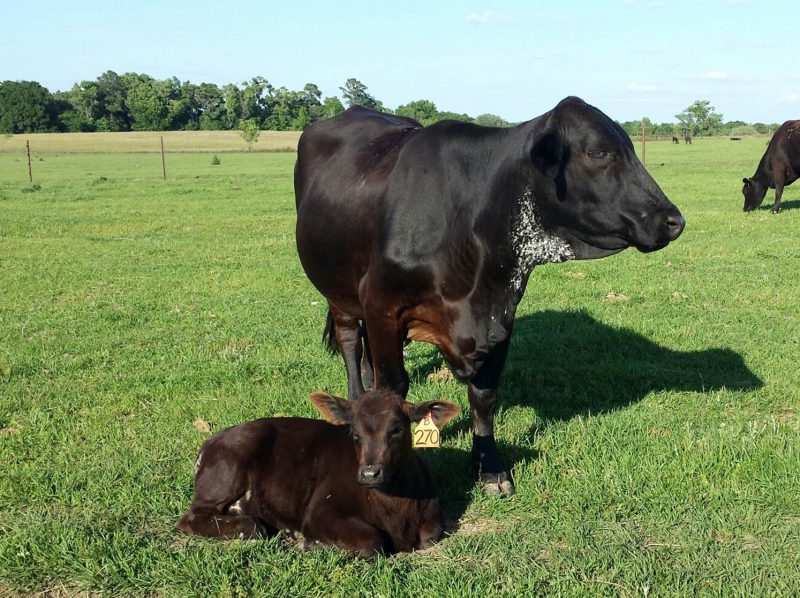Factors That Affect Beef Production How Much Do I Feed My Beef Cattle

Product decision for both the cow and calf affect ranch profit potential. Photo credit, Debbie Price; Alachua, FL)
Equally cattle ranchers look for means to create profitability in stagnant or down markets, operational expense and profit centers need to be examined. Many factors contribute to the overall profitability of the beef cattle functioning on an annual footing. Notwithstanding, there are iv points that consistently influence the profit potential. All iv are well within the control or straight influence of a rancher. These four areas are found across all herd sizes and locations, and then they are worthy of discussion.
1. Almanac Cost of Maintaining the Cow – The annual operating expense of the cow, the base product unit, is 1 of the largest expenses for the beef operation. USDA-ERS data for 2008 to 2017 estimates that the average annual operating cost of a cow in the US in 2018 was $562, with a total cost of $1,374 when all overhead is included. Certainly, this almanac moo-cow operating, and full cost varies by region and the input costs associated with feed, pasture, veterinary, marketing, involvement, labor, equipment, and other small price areas. Each of the toll areas should be scrutinized equally they contribute differently to the operating and overall costs; for case, feed costs account for 68% of operating costs, but simply 28% of the total costs, whereas labor costs contribute 35% of full costs associated with a beef cattle performance.
two. Percentage of Cows Weaning a Calf – In a moo-cow-calf operation in that location are two main sources of acquirement, weaned calves that are sold and cull animals – other sources of revenue are minor. For a moo-cow to bring revenue to the beef cattle performance she must produce a live calf that can be sold, or she is sold herself. The total operating costs of a beefiness cattle functioning is spread beyond all the cows that reside in the herd. The annual cow operating costs employ to all cows equally, therefore equally many cows equally possible need to contribute to the revenue puddle every bit possible by weaning a dogie. More calves spread the fixed and variable costs over more than animals, and equates to more than opportunities to generate acquirement. Ultimately the costs are nearly the same to maintain a moo-cow that weans a calf or non, simply a cow that weans a calf tin can generate more revenue.
three. Weaning Weight of Calves – Weaned calves are the chief source of revenue for the beef operation, as such the more pounds bachelor to sell, the more potential acquirement is generated. The weaning weight of the calf is influenced by several factors that include sire/dam genetics, cow milk production potential, dam/dogie wellness, pasture conditions, creep feeding, calf implant status, age at weaning, and several others. Much of what drives dogie weaning weights are decisions and management aspects that are under the control of the rancher.
iv. Price Received for Weaned Calves – The price received for the calves at the time of marketing is influenced past several factors controlled by the rancher, and many are are non. A calf that meets the demands of the market place can maximize the price received, calves that do no run into the expectations of the buyer are often discounted. The price received at marketing for weaned calves is afflicted by dogie management, i.e. is the dogie castrated, hair glaze condition and colour, breed type, weight, and number of similar calves in the sale lot. Selecting marketing options that encourage the opportunity to maximize sale price past attracting multiple purchasers, and marketing calves in larger groups of like animals increases the toll received for each calf.
The first three items are all controlled past cow-dogie diet and cow reproduction. Without attending to the overall cow nutritional program, and the subsequent reproductive performance, generating a turn a profit in a beef cattle enterprise is difficult. Optimizing the economic opportunities in a beef cattle operation are imperative for long-term success. Understanding where the toll centers are in a cow herd and working to minimize those expenses is important. Addressing fixed and variable annual costs of managing a cow involves data collection, adequate records, and not bad decision making. Likewise, moo-cow and calf performance and the subsequent revenue is ultimately reflective of the direction of the cow herd and the level of management applied to the calf.
Additional Resources:
Implications of Moo-cow Trunk Condition Score on Productivity
Factors Affecting Calf Selling Price at Marketing
- Author
- Recent Posts
Source: https://nwdistrict.ifas.ufl.edu/phag/2019/06/03/what-influences-profit-for-the-beef-cattle-enterprise/
0 Response to "Factors That Affect Beef Production How Much Do I Feed My Beef Cattle"
Post a Comment